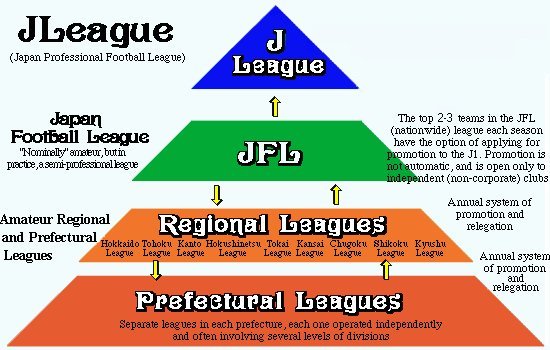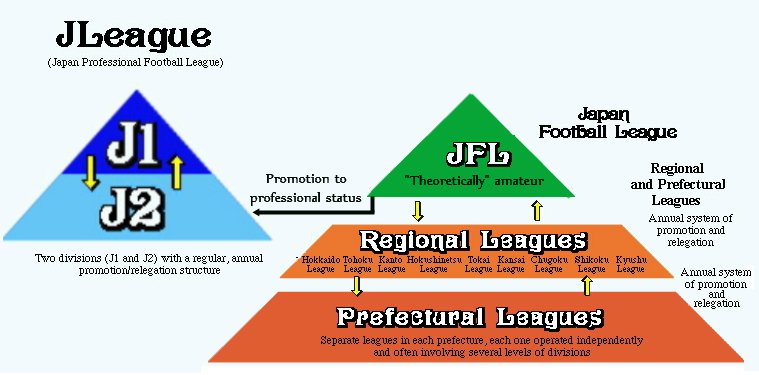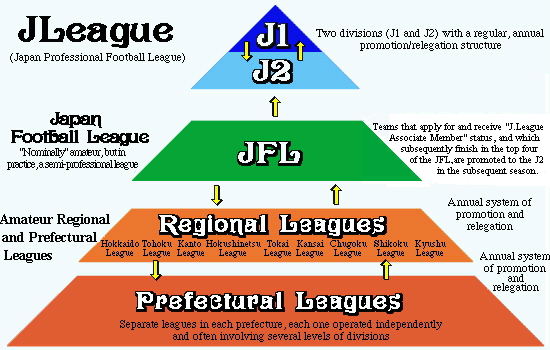The JFL and Regional Leagues
Amateur football in Japan has been popular and extremely well supported for nearly as long as is the case in many European countries. According to most historians, the first competitive game was played between two groups of British expatriates -- Kobe Regatta & Athletic Club (founded 18700 and Yokohama Country & Athletic Club (an amalgamation that came about in 1912 from various clubs formed in the late 1800s) -- in the 1880s. Over the years, a competitive "pyramid" developed in Japan, in much the same way that it developed in other football-loving countries, with local leagues feeding into prefectural leagues, regional leagues, and at the top of the pyramid, a nationwide "Japan Soccer League". Prior to 1993 this pyramid was very simple, and easy to understand. With the creation of the J.League, however, the structure of football organizations in Japan took on a very complex and often self-contradictory character. For about two decades, these contradictions were a source of constant friction between the professional J.League and the many amateur leagues across the country, which were overseen by the Japan Football Association (JFA).
For a variety of reasons, the J.League and JFA found themselves in conflict on a host of issues. Though the people in charge of the J.League and JFA were generally on good terms (many were former teammates, there was frequent movement of personnel from one organization to the other, and they even worked in the same building), the teams and individuals they represented had dramatically different interests, and this often led to disagreements that could best be described as "turf battles".
The situation changed from year to year, with periods of close cooperation interspersed with occasion angry disagreements and public posturing. The biggest problem related to the fact that amateur and professional football teams had different purposes and objectives, which were often in direct conflict. When the J.League was formed, it adopted the assumption that professional teams would occupy a "separate pyramid" from the amateur one. In practice, however, teams that wanted to join the J.League had to build their foundation while still inside the amateur pyramid. For almost two decades, the Japan Football League (JFL) epitomized the contradictions and conflicts between JFA and J.League. At one point, the (amateur) directors of the JFL were so upset that a few were prepared to "commit suicide" - disband the JFL and limit amateur football to prefectural and regional competitions. One team even did voluntarily disband. Sagawa Shiga FC, a team that had participated in the JFL in one form or another for twenty years, fired all of its coaches and trainers and released players in 2012, disappearing forever from the football landscape.
The reasons for this conflict will be discussed in greater detail below, but the "suicide" of Sagawa Shiga forced JFA and J.League to sit down and work out a permanent solution that would eliminate the contradictions once and for all. In 2013, an agreement on the future structure of football organizations in Japan was reached, and with the creation of the J3 in 2014, the structure of football organizations in Japan was permanently divided into separate amateur and professional pyramids. There is still a bit of a "grey area" due to the fact that amateur teams hoping to join the J.League in the future will continue to participate in the amateur pyramid until they have met all the requirements for J.League entry. However, the rules governing their status have been clarified, and teams that are "amateur by choice" no longer need to feel threatened by the existence of nominally professional teams in their midst.
For those interested in the full story, read on. For more data on JFL and Regional League teams, click one of the links below:
To understand the history of the JFL fully, it is necessary to discuss its role and function from two very different perspectives. The JFL has been through essentially three phases of existence (four, if you consider that the old Japan Soccer League (JSL) was essentially the same organization, and performed the same function from the standpoint of amateur clubs. Prior to the J.League era, the JSL represented the pinnacle of the football pyramid in Japan. In 1992, when the J.League was created, ten former JSL clubs split off to form a new, professional organization -- the J.League. The remainder of the clubs from the JSL's former two divisions merged, to create the JFL.
From its first incarnation, the JFL experienced internal friction between clubs who hoped to one day join the J.League and those which always intended to remain amateur. From the former group's perspective, the JFL was simply a stepping stone on the way to professional status. Teams with J.League ambitions no longer viewed the JFL as a league in which amateur teams compete for personal glory. It was merely a waystation, and winning the JFL title was nothing but a passport to J.League status.
However, even in those early days, there were a number of teams that were -- and always intended to remain -- completely amateur. The best examples (and the most competitive non-professional clubs over the next two decades) were Honda FC and Sony Sendai. These teams were made up of players who worked for the company during the day (Honda Motor and Sony, respectively), practiced after work, and played football matches on weekends. From their perspective, the JFL was the pinnacle of their ambitions, and a JFL championship was the ultimate prize to which they aspired.
The graphic below shows what the football pyramid in Japan looked like during the period from 1992 through 1999, when there was only one division above the JFL, known simply as the J.League.

Despite these dramatically different perspectives on what the JFL was supposed to represent, friction between clubs and league organizers was subdued for most of the next six years, because the balance of power within the JFL was heavily weighted in favour of the "wannabe professionals." A look at the JFL table from those years can explain the reasons. Apart from Honda, Sony Sendai and Denso (the company team of NipponDenso), nearly every team that played in the JFL during those years would end up in the J.League eventually. Honda, in particular, complained about the situation, expressing its disappointment with having to compete with "professionals" to win the title of "best amateur team in Japan." On the other hand, their annoyance was tempered by the fact that they frequently DID finish first, during that era, and thus had even more reason to brag.
The situation changed at the end of 1998. The J.League itself was experiencing a period of turmoil, as discussed in greater detail on a separate part of this site (see "J.League History: 1998"). The League had expanded too rapidly, and some of the smaller clubs were in financial distress. However, there were still a dozen teams in the JFL that were hoping to join the professional ranks. To deal with this problem, the J.League decided to "expand", while also splitting into two divisions. This would not only allow the remaining JFL clubs with pro ambitions to make the jump, but also reduce the competitive burden on those second-tier competitors who could not afford to build a team capable of remaining viable in the J1.
At least according to the J.League management at the time, the change was supposed to have another purpose. By absorbing all of the teams that were aiming for pro status, the J.League was planning to restore control of the JFL to amateur teams. Even during the 1993-98 period, the JFL was SUPPOSED to be an amateur league. As mentioned above, however, in reality all but 2-3 of the JFL members were clubs that intended to become fully professional at some future date. They were already spending a considerable amount of money on players, and to remain competitive, teams like Honda and Sony had to channel some money into their own "amateur" teams.
In theory, the creation of a J2 was supposed to separate the professional pyramid from the amateur pyramid. Though nobody put the principles into writing, it was assumed that most of the teams which WANTED pro status were already accounted for, and any that expressed their interest in joining the J.League in the future could be accommodated on a "case by case" basis.

The system worked in practice for about five or six years. One additional team wanted to become professional, but lacked the facilities to make the jump in 1999. This team was added to the J2 in 2000, as Mito Hollyhock. As the organizers anticipated, it was a fairly simple process to add the new team -- J.League teams voted their approval at the end of 1999, and Mito was added to the mix. All of the other teams in the JFL at the close of the century were amateur in both name and reality. It would be another four years before any other team emerged with hopes of joining the professional ranks. This left the amateur teams to enjoy the benefits of true amateur athletic competition. But this happy situation could not last. The success of the J1 and J2 prompted football teams and fans in all parts of the country to cast an envious eye at the cities and towns that played host to a J.League team. Before long there were a dozen or more teams emerging in the regional and prefectural ranks, with dreams of playing in a professional environment one day.
The "Third Wave" of J.League expansion began in 2004. At the start of the year, two teams in the JFL expressed their interest in joining the J2. The request was handled in ad hoc fashion, as the new format had originally envisioned. This was easy to accomplish because of the nature of the two teams in question. Tokushima Vortis had been around as a company team for many years under the name "Otsuka Kagaku FC" -- it was one of the teams that entered the JFL in 1999, when the J2 was created. Tokushima is the largest city on the island of Shikoku, and this made it a very suitable site for a new team. Even before 1999, some of the fans had pushed for Otsuka Pharmaceutical (where most of the team members worked) to let the team go independent, and join the J.League. After a few years of moderate JFL success, Otsuka finally gave in, and let the team spin off as "Tokushima Vortis". Their competitive potential was obvious, since Vortis won the JFL title in 2004, and the J.League was happy to open up a new market in the island of Shikoku.
The other team had slightly less solid foundations, but a great publicity story. Thespa Kusatsu was formed by workers in a hot spring resort in Gunma prefecture, north of Tokyo. Some of the players had personal connections to a few aging former J.Leaguers, and convinced them to come join the team as player/coaches. Former national team goalkeeper Nobuyuki Kojima and former Kashima Antlers defender Ryosuke Okuno came on board, and led the team on a gallop through the upper amateur ranks and into the JFL. At the end of 2004, Thespa thrilled the entire country by defeating Yokohama Marinos in the Emperor's Cup, despite being reduced to ten men before the start of overtime play. It was obvious to the J.League that Thespa would be a good "publicity boost", and their location in a previously untapped but populous part of the country was just one more point in their favour.
But the addition of two teams to the J2, in 2005, marked a watershed for both the J.League and the JFL. It was clear that a lot of other cities and towns in Japan wanted to create J.League teams, but without a set of ground rules telling teams how to qualify, the process of expansion would quickly devolve into chaos. Many foresighted people in the J.League management ranks actually foresaw this problem coming as early as 2003. They had been working on a blueprint for growth that would soon come to be known worldwide, as "The Hundred Year Plan".
The Plan itself is discussed elsewhere on this website. For the JFL, the key issue to notice is that when they launched their new "Hundred Year Plan", the J.League management unilaterally decided to revert to the sort of pyramid structure that prevailed prior to 1999. The JFL was never consulted, and the amateur teams that made up the JFL were expected to either join the enthusiastic rush towards professionalism, or just keep their mouths shut.

The Hundred Year Plan is a magnificent piece of work, combining visionary ideas about the future of football in Japan and uplifting themes of grassroots fan support, local identity and fair competition that benefits all participants with very precise, carefully considered plans and exhaustive detail covering everything from financial support and limits on the relationship to for-profit companies to the precise lux value required for stadium illumination, in order to qualify for each level of the J.League pyramid. Sadly, the people who created the plan did not take into account the impact that their new plan would have on amateur football. This may not be surprising -- after all, the JFA is in charge of looking after amateur teams and leagues, not the J.League. However, the lack of any consideration for amateur football was a source of annoyance to the JFA, and an unending headache for the people trying to run the JFL, and those teams that chose to remain amateur.
As the first decade of the 21st century advanced, the trickle of "J.League wannabe" teams into the JFL's ranks quickly increased to a flood, and amateur teams like Honda, Sony Sendai and Sagawa Kyubin soon found it impossible to remain competitive in the JFL without spending huge sums of money to support their teams and players. Even in the 2005-06 period, the amateur members of the JFL complained about the de facto professionals in their midst. As one unnamed source told the Rising Sun News in 2007: "the JFL was supposed to be the top level of AMATEUR football in Japan -- not some nursery /daycare center for baby J.Leaguers."
The situation came to a head in 2012, when Sagawa SC -- bankrupted by the cost of keeping up with the professionals -- announced that it was voluntarily closing down, releasing all its players and staff, and bidding goodbye to football altogether. Like many other acts of "seppuku" (ritual suicide) in Japanese history, this act of self destruction was intended to send a message to the J.League: Either return us to the pyramid structure that we THOUGHT was created in 1999, or amateur football in Japan just might collapse altogether. Though the J.League itself was in robust health, as the third wave of expansion rolled along, they too had reached the limit of the J2's capacity to absorb new teams. A new model for expansion had to be introduced, and the turmoil in the JFL illustrated the dangers if they did not introduce a new model soon.
Thankfully, Sagawa's sacrifice was not in vain. The following season (2013) the J.League set up its "J3 cultivation program", promising to add a third professional division once there were enough teams ready to make the jump to pro status. The JFL, JFA, and all the amateur teams that planned on maintaining their amateur status were assured that -- when the J3 kicked off -- control of the JFL would be returned to amateur management.
By the end of the year, the goals of this cultivation program had been met. The quick response of "wannabe" teams helped, but intense pressure from the JFL ensured that the J.League did not drag their feet. In 2014 eleven teams (all of which had been professional in everything but name for at least a few years) were inducted into the professional ranks, as members of a J.League 3rd Division. The new pyramid structure is illustrated below.

Under the new system, teams of "J.League wannabes" will still rise through the amateur ranks until they are ready to join the J3, but under the new rules there is less emphasis placed on performance on the pitch, and more focus on the structural and financial viability of the club. Amateur JFL teams will have a much easier time placing high in the JFL league table, and the "wannabes" will not be under pressure to outdo amateur opponents on the pitch, if they want to make the jump to pro status.
There is still enough vagueness in the rules to worry some observers. If the J.League fails to follow through on its pledges, there is little that the amateur JFL can do to force compliance (apart from another public display of dissatisfaction). Having said that, the eased "performance" conditions for J.League entry (in theory, teams placing as low as fifth or sixth in the JFL can be promoted, once they earn J.League Associate Member status) should ensure that once a team clears the organizational hurdles, it will quickly move on, and not linger for several years in the JFL, as was the case in 2004-13. With this reorganization of the pyramid, the J.League now embarks on its fourth phase of growth. Hopefully its presence now will serve as a source of energy and excitement for those in the amateur game, and not as a source of instability.

